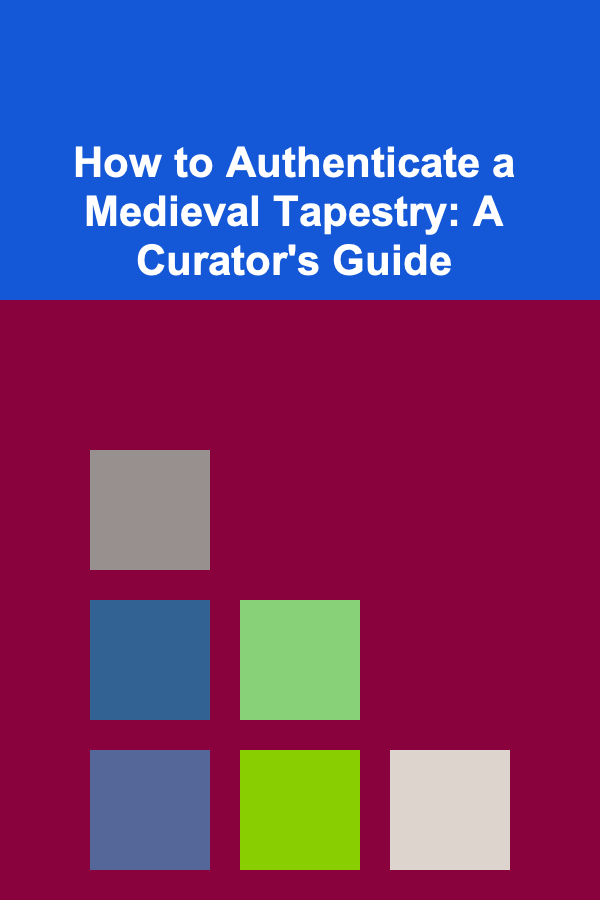
How to Authenticate a Medieval Tapestry: A Curator's Guide
ebook include PDF & Audio bundle (Micro Guide)
$12.99$7.99
Limited Time Offer! Order within the next:

The authentication of medieval tapestries is a complex and nuanced process that requires a combination of scientific analysis, historical knowledge, and an understanding of craftsmanship. As invaluable artifacts from a rich cultural era, medieval tapestries provide insights into the medieval world, its art, and the fabric of its society. These textiles, often created by skilled artisans and adorned with intricate designs, are also subject to forgery, deterioration, and misinterpretation. For curators, collectors, and art historians, the ability to authenticate a medieval tapestry ensures the preservation of history and provides context for further study.
In this article, we will explore the key methods used by curators and experts to authenticate medieval tapestries. The process involves a careful examination of materials, techniques, provenance, historical context, and scientific tests. Understanding these processes not only aids in authenticating these treasures but also ensures their protection for future generations.
1. Understanding Medieval Tapestries
Before diving into the methods of authentication, it is essential to understand the role and significance of medieval tapestries in history. Medieval tapestries were woven wall hangings, primarily produced from the 14th to the 16th centuries, and often served both decorative and functional purposes. They were commonly found in palaces, churches, and castles, where they provided insulation and contributed to the aesthetic grandeur of the space. These tapestries often depicted scenes from religious texts, myths, historical events, or chivalric tales.
The production of a tapestry was a labor-intensive process that involved weaving fine threads into a fabric, often using intricate patterns and vibrant dyes. Tapestries were created on large looms, and artists (or designers) would typically sketch out the images that would later be translated into woven art. The highest quality tapestries were made using silk, wool, and sometimes gold or silver threads, making them highly valuable.
2. Materials Analysis: Identifying the Fiber and Dyes
One of the first steps in authenticating a medieval tapestry is the analysis of its materials. The fibers used to weave a tapestry and the dyes employed in its creation can provide significant clues about its age, origin, and authenticity.
a. Fiber Analysis
Medieval tapestries were typically woven from wool and silk, with variations in the types of threads used depending on the region and the period in which they were made. Wool, being more widely available and durable, was commonly used for the body of the tapestry, while silk threads were often employed for more intricate designs or to highlight specific elements.
Modern synthetic fibers, such as nylon or polyester, were not used during the medieval period and are an immediate indicator of a modern reproduction. The identification of the fibers in a tapestry can be achieved through techniques such as:
- Microscopic analysis: A close inspection under a microscope can reveal the type of fibers present in the tapestry. Wool and silk fibers have distinct characteristics that can be distinguished from synthetic alternatives.
- Polarized light microscopy: This technique allows curators to examine the natural fibers' structure and determine whether they match the composition of medieval threads.
b. Dye Analysis
The dyes used in medieval tapestries were often derived from natural sources, such as plants, minerals, and insects. Some common dyes included indigo for blue, cochineal for red, and woad for purple. Modern synthetic dyes, which became widespread only after the 19th century, are easily distinguishable from their natural counterparts.
To authenticate the dyes in a medieval tapestry, curators may use advanced scientific methods like:
- Chromatography: This technique separates and identifies the chemical components of the dyes. By comparing the dye components to known medieval samples, curators can assess their authenticity.
- Infrared spectroscopy: This method uses infrared light to examine the molecular structure of the dyes. It can detect the presence of specific compounds found in medieval dyes.
3. Weaving Techniques and Construction Methods
The techniques used to weave a tapestry are critical for its authentication. Medieval tapestries were typically woven using specific methods that were common in the period, including the use of a vertical loom and a specific type of knotting technique. Analyzing the weave of a tapestry can reveal much about its origins and time period.
a. Weaving Patterns and Looms
Medieval tapestries were often woven on vertical looms, which allowed for more intricate designs than those woven on horizontal looms. This method required the artisan to weave from bottom to top, using techniques such as slit tapestry (where the background and foreground are woven separately) or soumak weave (a decorative technique for creating patterns).
To determine the authenticity of a tapestry, experts may look for certain characteristics in the weave:
- Thread count and weaving density: Medieval tapestries tend to have a more uniform thread count than later reproductions, and the weft threads (the horizontal threads) may be slightly visible.
- Selvedges: The edges of medieval tapestries were often finished with a particular type of stitch to prevent fraying, and examining the selvedge can help determine if the piece was woven in the medieval style.
b. Finishing Techniques
The way a tapestry was finished can provide further evidence of its age. Medieval tapestries often featured hand-stitched finishes, including hemmed edges, fringes, and borders. In contrast, modern reproductions may feature machine-finishing methods.
4. Provenance and Historical Context
One of the most vital aspects of authenticating any historical artifact is establishing its provenance---the history of ownership and transfer. Provenance provides an important context for the tapestry and can validate its authenticity by confirming its origin and ownership history.
a. Documentary Evidence
Curators often begin by reviewing historical documents, such as inventories, sale records, and correspondence, that might link the tapestry to a specific place, time, or owner. In the case of medieval tapestries, documentation from prominent medieval collections or royal courts can provide valuable clues. If a tapestry can be traced back to a specific commission or historical event, it adds credibility to its authenticity.
b. Provenance Research
Provenance research is often conducted to identify past owners of a tapestry. The ownership history of a piece may provide insights into whether the tapestry was part of a known collection or commissioned by a particular patron. Tapestries owned by royal families, monasteries, or wealthy individuals often have more documented histories than those from less well-known collections.
While provenance is not always an indicator of authenticity, a tapestry with a well-documented and consistent ownership history is less likely to be a forgery.
5. Iconography and Artistic Style
Medieval tapestries were often designed to reflect the social, political, and religious climate of the time. Understanding the iconography and artistic style of a tapestry is essential for its authentication. The imagery depicted in these textiles can provide clues about the period in which they were created.
a. Iconographic Analysis
The imagery found in medieval tapestries was highly symbolic, often rooted in religious or mythological themes. A tapestry featuring scenes from the Bible, chivalric legends, or medieval courtly life can be analyzed for stylistic and thematic consistency with other works from the same period. If the themes depicted do not align with the known iconography of the time, the tapestry may be suspect.
Curators may examine:
- Symbolism: Certain symbols, such as animals, plants, and heraldic motifs, were common in medieval art and tapestries. Understanding the symbolism can help identify whether the tapestry adheres to the conventions of its time.
- Costumes and architecture: The clothing styles, architectural details, and settings depicted in the tapestry provide important information about the period and location of its creation.
b. Artistic Style and Regional Influences
Tapestries were often made in different regions, such as Flanders, France, and Italy, each with its own distinct artistic style. For example, Flemish tapestries from the 15th century often exhibit intricate detail and vibrant color schemes, while French tapestries from the same period may be more subdued in color and composition. By analyzing the artistic style, curators can determine if the piece fits with known regional practices.
6. Scientific Testing: Carbon Dating and Other Techniques
In some cases, scientific techniques may be used to verify the age of a tapestry. While carbon dating is often associated with organic materials like wood or bone, it can also be applied to certain fibers used in tapestry weaving.
a. Radiocarbon Dating
Radiocarbon dating is a useful tool for determining the age of organic materials, such as the fibers or dyes in a tapestry. By measuring the amount of carbon isotopes present in the materials, scientists can estimate when the tapestry was created. However, this method has limitations and is not always applicable to all types of fibers.
b. X-ray Fluorescence (XRF)
X-ray fluorescence is a non-destructive technique that can be used to analyze the chemical composition of the dyes and fibers in a tapestry. This method helps identify the elemental makeup of materials and can be used to detect any modern materials or synthetic dyes.
7. Consulting with Experts and Art Historians
Given the complexity of tapestry authentication, curators often consult with experts in specific areas, including art historians, textile specialists, and scientists. These experts bring a wealth of knowledge and experience to the process and can help interpret findings from material analysis, stylistic analysis, and scientific testing.
Additionally, international collaborations between museums and academic institutions can provide valuable resources for the authentication process, as curators share knowledge and research findings about specific periods, techniques, and artists.
Authenticating a medieval tapestry is a multi-faceted process that combines art history, science, and practical expertise. Through a careful examination of materials, weaving techniques, iconography, provenance, and scientific analysis, curators and experts can determine the authenticity of these historical treasures. Given the significance of medieval tapestries in understanding the cultural, religious, and political landscape of the past, the process of authentication is not only a matter of verifying age and origin but also of preserving and appreciating the artistic and historical value of these remarkable works of art. As new technologies and research methods continue to develop, the process of authentication will evolve, but the fundamental principles of understanding materials, craftsmanship, and historical context will remain at the heart of this essential work.
Reading More From Our Other Websites
- [Home Lighting 101] How to Use Lighting to Create a Relaxing Home Theater Room
- [Biking 101] The Ultimate Guide to Triathlon Bikes: Features and Benefits
- [Rock Climbing Tip 101] Memorable Moments in International Climbing Competitions
- [Organization Tip 101] How to Organize Your Computer Desktop for Better Workflow
- [Organization Tip 101] How to Manage Time Wisely During Busy Seasonal Periods
- [Home Soundproofing 101] How to Use Heavy Furniture for Natural Soundproofing
- [Toy Making Tip 101] Best Time‑Saving Hacks for Mass‑Producing Small‑Batch Wooden Toy Trains
- [Organization Tip 101] How to Utilize Community Resources for Seasonal Projects
- [Home Budget 101] How to Budget for Family Vacations Without Breaking the Bank
- [Scrapbooking Tip 101] Color Theory in Scrapbooking: How to Choose the Perfect Palette for Your Layouts

How to Clean and Maintain Your Home's Hot Tub or Spa
Read More
How to Track Your Spending Habits to Avoid Financial Leaks
Read More
How to Navigate the Historic District of Savannah
Read More
How to Build a Safe Haven for Birds in Winter
Read More
Step-by-Step Solutions for Modern Living
Read More
How to Repair Common Skateboard Damage
Read MoreOther Products

How to Clean and Maintain Your Home's Hot Tub or Spa
Read More
How to Track Your Spending Habits to Avoid Financial Leaks
Read More
How to Navigate the Historic District of Savannah
Read More
How to Build a Safe Haven for Birds in Winter
Read More
Step-by-Step Solutions for Modern Living
Read More